San Gennaro LCN App
Little Italy New York: Feast of San Gennaro and hidden secrets of a legendary neighborhood. One particular place in New York fascinates many people who wish to visit it. We are talking about Little Italy, an area rich in history, since in the late 19th and early 20th centuries it welcomed thousands of immigrants from Italy.
These people brought with them, traditions, customs and one of the world’s most appreciated gastronomies. Over the centuries, the people who contributed to the area have layered their efforts with the changes, resulting in a perfect balance that is still recognizable today.
Where is Little Italy New York located?
In New York City, there are two neighborhoods officially called Little Italy. Primarily, we have the Mulberry Street area in Manhattan and Arthur Avenue in the Bronx.
Mulberry Street in Manhattan and Arthur Avenue in the Bronx
Arthur Avenue, also known as “Little Italy,” is situated in the Belmont area of the Bronx and renowned for its authentic Italian-American ambiance. The origins of Arthur Avenue trace back to 1792. In that year, Pierre Lorillard transferred to New York and created the initial tobacco firm, “P. Lorillard & Co”.
The “unofficial” Little Italy: Bensonhurst
However, there is a third lesser-known and unofficial area, Bensonhurst. It is a neighborhood in the southwestern part of the borough of Brooklyn. It is bordered by Bath Beach to the west, Gravesend to the south, and Midwood to the east. The neighborhood is known for its large Italian-American population and its vibrant community. Bensonhurst has a rich history dating back to the 19th century, when it was primarily farmland and rural communities. It began to develop into a residential neighborhood in the early 1900s and continued to grow throughout the 20th century.
Today, Bensonhurst is home to a diverse community of immigrants from all over the world, including Chinese, Russian, and Middle Eastern communities. Although not defined as an Italian neighborhood, it is considered a small Italian neighborhood by residents and local New Yorkers in Brooklyn.
In this article, we will focus on the Little Italy of Lower Manhattan. Originally located as a large 30-block section of the Lower East Side, Little Italy is now enclosed in a series of blocks around Mulberry Street.
It is bordered to the west by Tribeca and Soho, to the south by Chinatown, to the east by the Bowery and Lower East Side, while to the north it is contiguous with Nolita.
On Mulberry Street it stretched south to Worth Street, north to Houston Street, west to Lafayette Street, and east to the Bowery. It originated in Mulberry Bend south of Canal, in what was once the Five Points area, currently the heart of Chinatown.
Although now smaller in size, the neighborhood retains an inkling of its Italian-American past. Its complex history is easily seen in the buildings painted red, white, and green and the stores with generous storefronts filled with cured meats and aged cheeses.
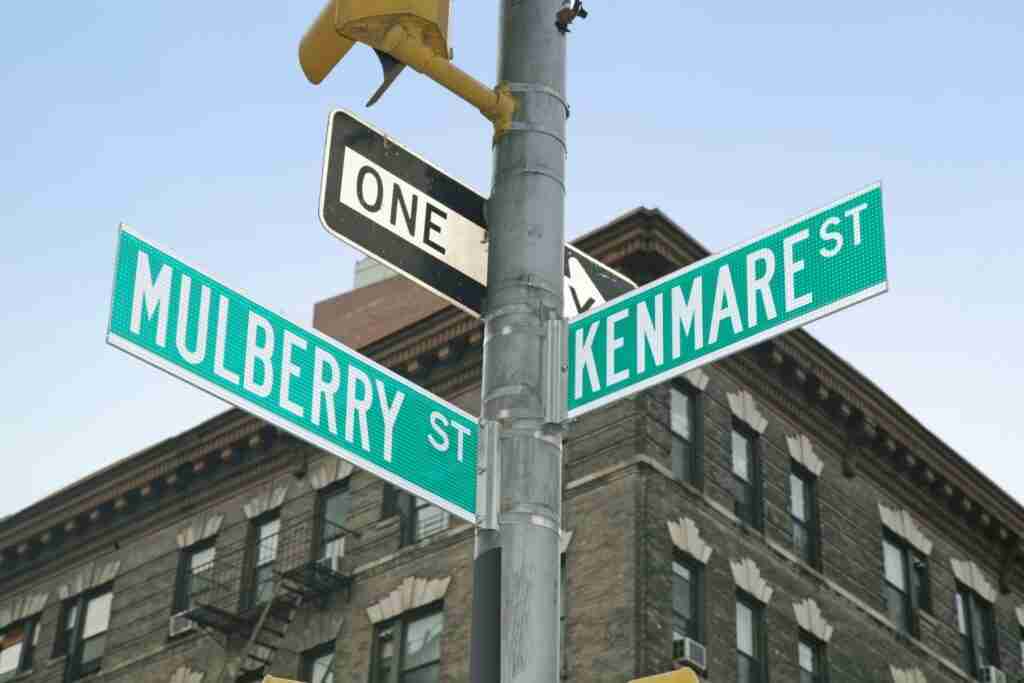
The history of Little Italy in New York City
The origins of Little Italy in New York City are at once shrouded in the past and rooted in the present. Several waves of immigration from the shores of Italy enshrined the birth of Little Italy, but originally, the streets between Worth Street and Houston Street were home to ethnic groups such as the Lenape Indian tribes and settlers from Holland.
Now more than two centuries ago, several waves of immigrants from Italy arrived from their homeland seeking their fortunes in the United States to take advantage of the growing industrialization in America. Italians transplanted to New York City first occupied the streets within the Lower East Side housing projects, along with other expatriates who had settled there for centuries.
In the twenty years between 1860 and 1880 at least 68,000 Italians were now permanent residents of New York City. While many Italians resided in Lower Manhattan’s Little Italy, others moved to East Harlem and created a larger Little Italy.
The 1920s and 1930s in New York City
In the Roaring Twenties, at least 390,000 Italians settled in New York City from East Harlem to the Lower East Side. From the outside, Little Italy appeared to be a positive center of Italian culture, from language to cuisine to traditions.
However, things were really complex. Similarly to Italy Manhattan’s little paradise was fractionalized into regional realities. In fact, the Sicilians gathered on Elizabeth Street, the Genoese on Baxter Street, and the Italians from Northern Italy, occupied Bleecker Street. The experience of visiting those spaces in the early 20th century brought with it the possibility of discovering different scents and dialects from street to street. Just as would happen when traveling through different regions of Italy. Of course, the Italians also brought to the United States their traditional recipes. Which quickly won the hearts of New Yorkers and beyond. At that time Italians loved to spread not only their cuisine. But also many of the Italian traditions, such as puppet shows in the streets to entertain passersby.
So it was that by the late 1930s, practically 98 percent of Little Italy was inhabited by Italians. But after World War II, so many of them moved to Brooklyn, Staten Island and other boroughs. In the second half of the 20th century, Little Italy appeared in several movies, from The Godfather to Mean Streets. In recent years, Little Italy is smaller due to the expansion of SoHo and Chinatown. Mulberry Street and the surrounding streets still show the continuing impact of the thousands of Italians who lived and brought their contributions to life in the Big Apple.
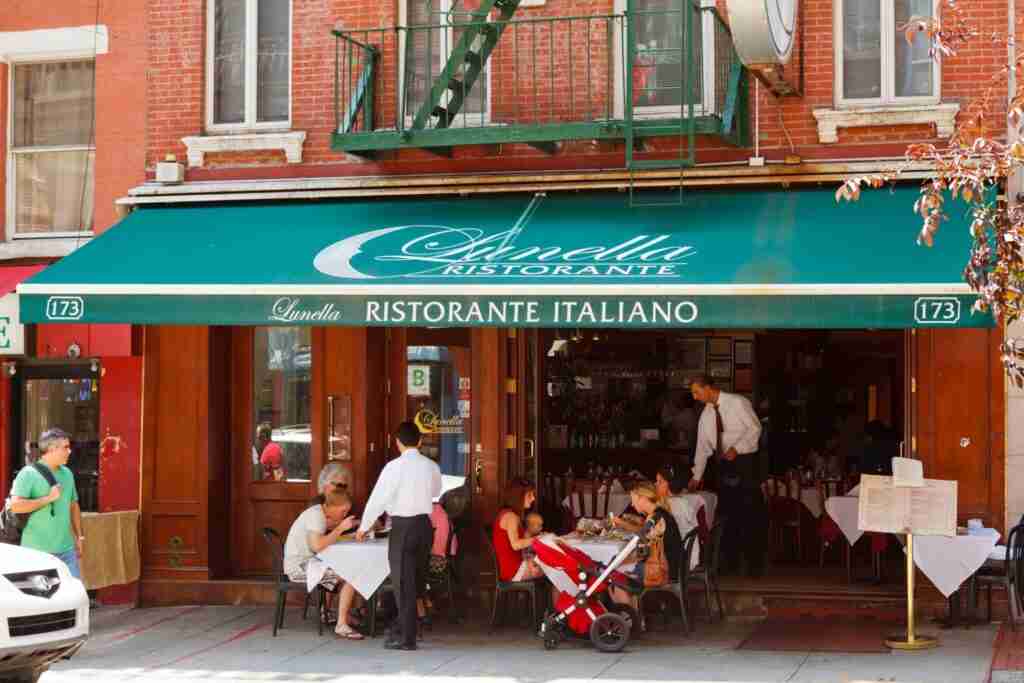
What to see in Little Italy New York?
So many people come to the streets of Lower Manhattan to try the typical flavors of Italy and perhaps taste the best pizza in town. In fact, there are so many stores and restaurants that have been offering typical cuisine now for more than a century. These are fantastic places to eat great food, which you can also discover through LCN App. Apart from the food, these dynamic and energetic streets are full of cultural attractions, obviously closely related to the culture of Italy. Let’s see together what to see in Little Italy New York.
Center for Italian Modern Art
Established in 2001, the museum is located in the former Stabile Bank. A former financial center for Italian immigrants in the late 19th century. The institution documents cultural, social and political contributions of Italians to America. Specifically, the focus is on New York City, through exhibitions on immigration, local churches and photographic looks at Italian neighborhoods and cities.
Located on the border of Soho and Little Italy, the Center for Italian Modern Art promotes modern Italian art in the United States, as well as internationally. At this center, you can often see the works of great Italian artists such as metaphysical painter Giorgio de Chirico or Bruno Munari.
St. Patrick’s Old Cathedral: the first cathedral in New York City
The ancient religious center dedicated to St. Patrick boasts the designation of New York City’s first cathedral. Built between 1809 and 1815, it was originally the seat of the Catholic Archdiocese of New York City. In addition, this place was a center of refuge in the 1800s when Italian immigrants were attacked by the Irish. The historical events we are talking about are told in Martin Scorsese’s film Gangs of New York. Not many people know that director Scorsese himself served as an altar boy in the church as a boy.
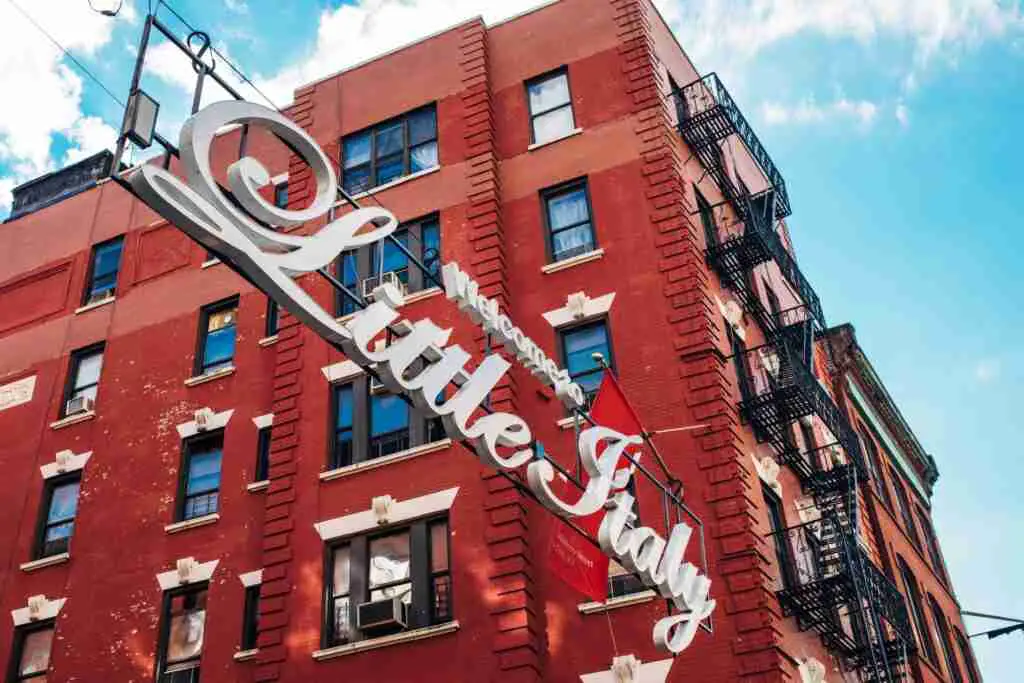
Shrine Church of the Most Precious Blood
This church is home to a statue of the very famous martyr San Gennaro. This sculpture is celebrated through a neighborhood procession during the Feast of St. Gennaro, which we will discuss later. This Roman Catholic church built in the late 1800s, in 2015 it merged with the old St. Patrick’s Cathedral. The most important religious event is held on September 19, the day of San Gennaro. After the solemn mass, a procession with the Statue of San Gennaro will branch out through the streets of Little Italy.
Feast of San Gennaro Little Italy New York: a celebration that will be 97 years old in 2023
The Feast of San Gennaro is an event celebrated every year in September since 1926. It is one of the most popular festivals in New York City. And in 2023 the Feast of San Gennaro in New York City will be 97 years old. On the streets of Little Italy, along Mulberry Street between Canal and Houston Streets, musical entertainment is located at the corner of Grand Street and Mott Street. The festivities last 11 days. And for the occasion Mulberry Street in Little Italy is transformed into a celebration of Italian-American culture and customs.
Musical performances, parades, processions and lots of gastronomy: cannoli, fried pasta, nougat, pizza and much more. The festivity stems from the Neapolitan tradition linked to San Gennaro, the beloved and devout patron saint of Naples.
This feast is an annual event eagerly awaited by Italian-Americans, tourists and New Yorkers alike.
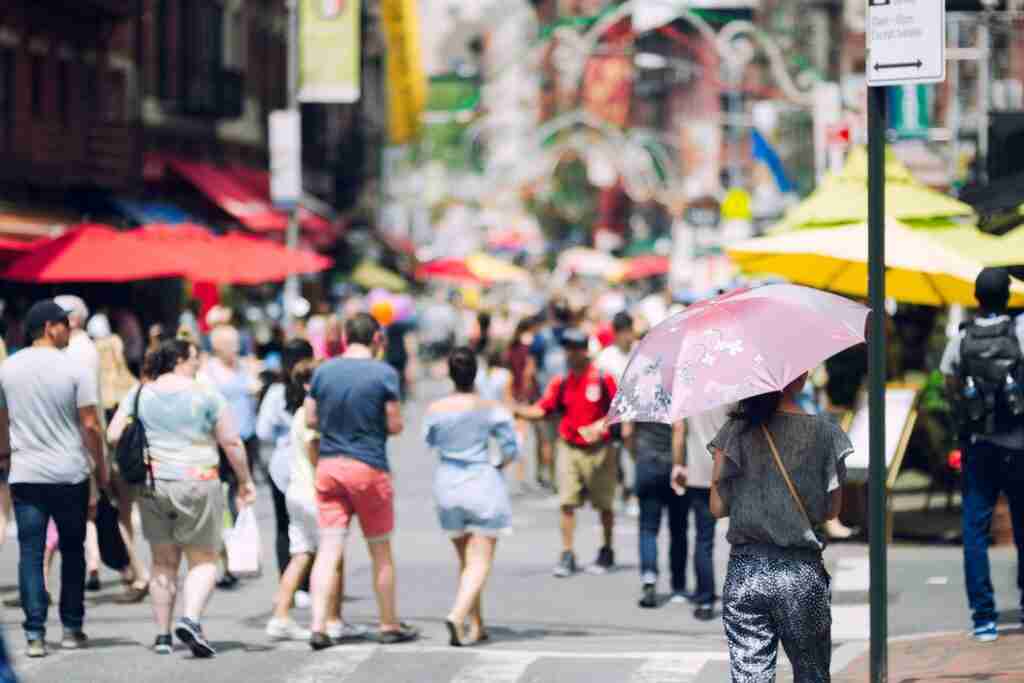
When is the Feast of San Gennaro 2023?
The presumed dates for the Festa di San Gennaro 2023, are Sept. 14-24, 2023. Music, dancing and great Italian food will draw about a million people to the historic streets of Little Italy over the 11 days dedicated to the festival. It is organized by the “Sons of San Gennaro” committee. Which since 1996 has been in charge of planning the festival that combines the sacred and the profane.
What to expect from New York’s Feast of San Gennaro?
Near the musical stages, you will find stalls selling the best delicacies of the southern culinary tradition. It will be possible to taste from spaghetti to pizza. Also, attend religious ceremonies and participate in the procession with the statue of the patron saint of Naples.
One of the most anticipated events is the cannoli eating contest that will take place outside the Palermo Café, 148 Mulberry Street.
In short, in the beating heart of the most hectic and modern metropolis in the world, the traditions and the memory of the Italian emigrants, are enjoying great success. A celebration where religion and folklore, mix and survive over the years. Counted as one of the major Italian-American festivals in the States. Certainly, if the Feast of San Gennaro has been attracting more than a million people for almost a century, there is more than one reason!
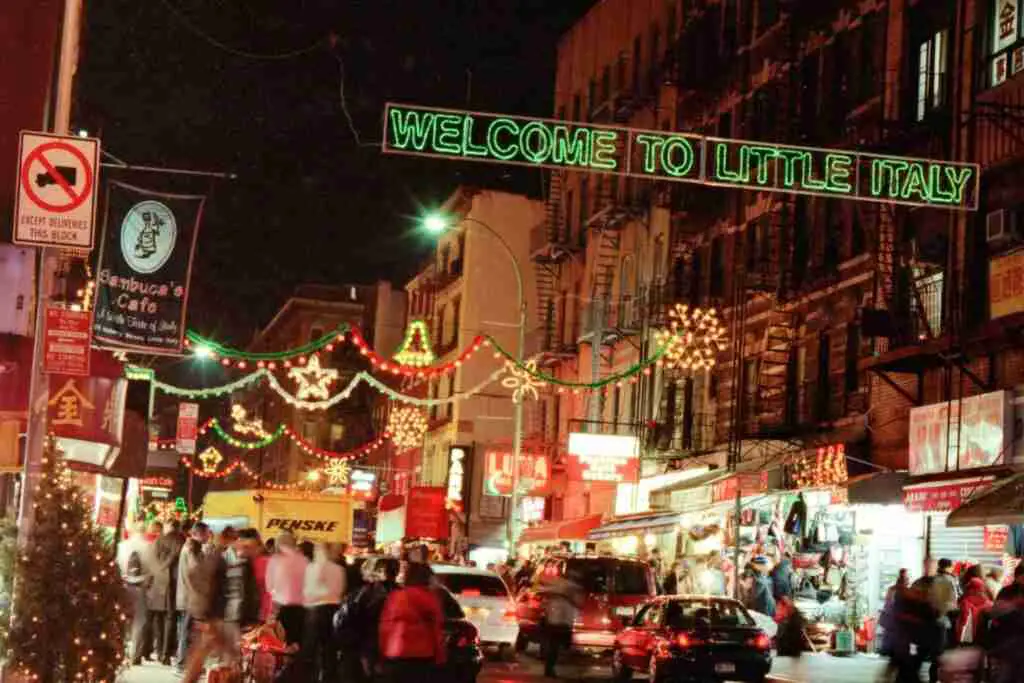
The Bottom Line
The beauty of Little Italy in New York is something unique and fascinating. This historic neighborhood has been the heart of New York City’s Italian community for generations. And it still retains much of its charm and authenticity, especially during celebrations such as the Feast of San Gennaro. The narrow streets full of life, outdoor cafes, traditional restaurants, and craft store windows create a lively and welcoming atmosphere. In addition, the neighborhood is rich in history and culture, with numerous historic buildings and monuments. Here you can find museums celebrating the Italian heritage of Little Italy and New York City in general. In conclusion, Little Italy is a must-see destination. An experience for anyone who loves Italian culture and history. And the unique atmosphere of an authentic neighborhood all to experience in the Big Apple.

